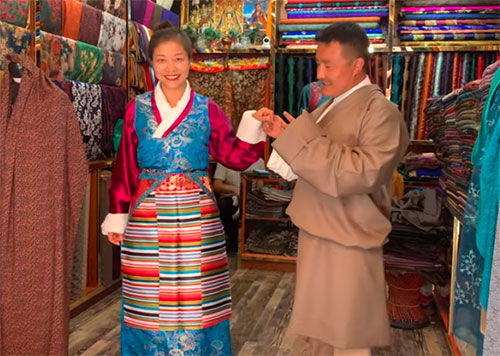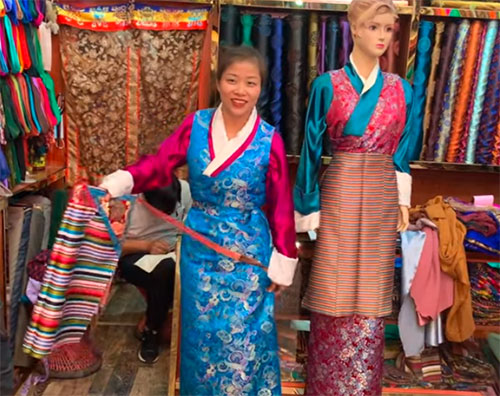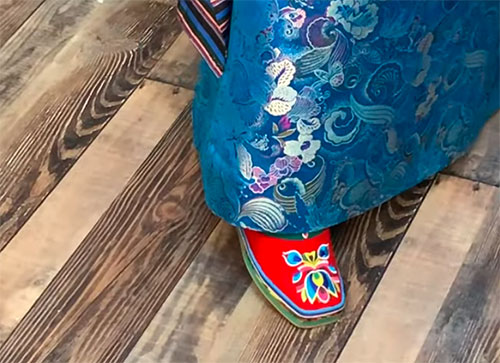 Tibetan women use lovely folk garments. Even today, they often dress in traditional clothing because it’s comfortable for the local climate and lifestyle and looks pretty. But to wear this attire accurately, a woman needs to know a few tricks and secrets. For example, how to drape the collar of every next layer of clothing or whether to put on an apron or what to do with extra-long sleeves, etc. At the same time, when everything is worn just right, a woman really stands out from a crowd and shines – she’s vivid, she’s feminine, she’s beautiful.
Tibetan women use lovely folk garments. Even today, they often dress in traditional clothing because it’s comfortable for the local climate and lifestyle and looks pretty. But to wear this attire accurately, a woman needs to know a few tricks and secrets. For example, how to drape the collar of every next layer of clothing or whether to put on an apron or what to do with extra-long sleeves, etc. At the same time, when everything is worn just right, a woman really stands out from a crowd and shines – she’s vivid, she’s feminine, she’s beautiful.
Some people think that Tibetan folk dress is dark and dull, but in reality, it can be really colorful. Even male traditional costumes – the festive ones – are bright and colorful. Like the one you can see here: Tibetan men used to dress in sheepskin outerwear over bare skin, leaving the right arm exposed even in winter. Female outfits are even prettier – floral and striped patterns, costly silks, vivid colors, etc.
In summer, Tibetan women prefer to wear light garments made from fine silk. The prints are often floral. Silk fabrics help the locals cope with the summer heat. For colder seasons, a variety of cotton, cashmere, and other warmer fabrics is used. Of course, the winter color palette is simpler and darker – brown, green (olive, army, juniper shades), royal blue, gray, and similar shades are popular. Also, winter clothes are usually plain, with fewer prints and decorations. Or these prints aren’t as colorful and eye-catching as on summer dresses.

Tibetan authentic women’s attire consisted of a white blouse (underwear piece) called “anjug”, a colorful outer blouse, a dress called “chupa”, and apron for married women called “bangdian”, and shoes.
As folk costumes are still rather often worn in Tibet, some improvements had to be made because clothing techniques aren’t frozen in time, they develop and offer new trends and possibilities. One of such new inventions is using just white cuffs and collar attached to a colored blouse instead of an undershirt. One less layer of clothes in summer means more comfort.

But when or if a white anjug blouse is used, it has a specific design. It is loose, plain, without any embellishments, with rather long sleeves (because the cuffs are rolled over the outer blouse’s cuffs), the front is closed one flap over the other, and it has a kind of a shawl collar. The white cuffs and collar always peek from under the next layers of clothing.
Tibetan traditional chupa dress is put over both inner and outer blouses. The shape of the collar of this dress is the same as on blouses, so every layer underneath is visible. The dress is worn over the head and then closed and fitted with buttons and elastic ties. Moreover, the blouses are tucked under the dress so that the collar forms a beautiful accent at the front of the outfit. The chupa has a belt attached to it at the waist, which is secured at the back, and it helps create the needed feminine tight-fitting silhouette.

Also, such a significant Tibetan folk garment as a so-called “bangdian” or apron remains intact even in the 21st century. This item helps people distinguish the marital status of a woman – only married women traditionally wear a bangdian. This apron is striped but the color and width of stripes can be different – every woman chooses what she likes.
The folk Tibetan female shoes are lovely. They’re handmade, bright, and beautifully adorned with embroidery.

Photos are from: https://www.youtube.com/watch?v=AjZ5jkYW70Y


